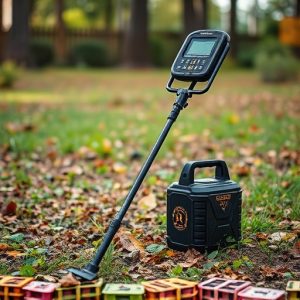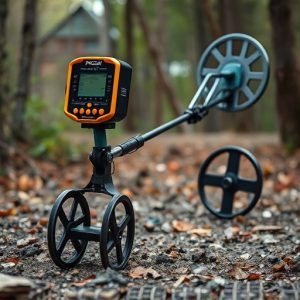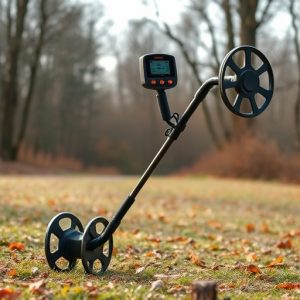Getting Started with Your ProScan Metal Detector: A Comprehensive User Guide
The ProScan metal detector is a sophisticated and versatile tool for finding hidden metals. To get …….
The ProScan metal detector is a sophisticated and versatile tool for finding hidden metals. To get the best out of it, start by ground balancing to match your search area's mineralization. Adjust the sensitivity to filter out noise and enhance depth perception, and fine-tune the discrimination feature to ignore unwanted metals. The device's audio tones and visual IDs will guide you in identifying different types of metal. Use a systematic search pattern, such as overlapping swings or a grid, to cover your area thoroughly without missing any targets. Regularly test your settings with known objects to ensure accuracy. By mastering the ProScan's features and employing effective search techniques, you can enjoy successful treasure hunting adventures. Remember to adjust your coil height for different sizes and depths of targets, and vary your search pattern to maximize your chances of finding valuable metallic items.
Embark on a treasure-hunting adventure with confidence using your ProScan metal detector. This comprehensive guide is designed to streamline your experience from setup to uncovering hidden gems. Begin by familiarizing yourself with the components upon unboxing and follow the straightforward steps for initial configuration. Gain proficiency in operating the device’s features through our detailed control guide. Learn how to fine-tune sensitivity and discrimination settings to enhance detection capabilities. With expert advice on interpreting signals and pinpointing target metals, you’ll master ProScan metal detection technology. Enhance your search techniques with our efficiency tips, ensuring every swing of your detector brings you closer to your next discovery.
Unboxing and Setting Up Your ProScan Metal Detector
Upon receiving your ProScan metal detector, the initial step is to unbox it with care, ensuring all components are accounted for. Lay out the metal detector, headphones, battery, and any included accessories such as a digging tool or pinpointer on a clean, flat surface. Carefully remove the battery compartment cover and insert the provided batteries to activate the device. Follow the user manual’s instructions to assemble any pieces that may need to be connected, like the search coil and rod assembly. Next, power on your ProScan metal detector and navigate through the menu options to set the sensitivity, discrimination patterns, and mode settings according to your intended use. The ProScan model you have may offer different frequencies or search modes, so choose the one that best suits the type of metal or targets you’re looking for. Once these initial settings are configured, you can proceed to conduct a test run indoors or in a familiar outdoor environment to ensure everything is functioning correctly. Adjust the audio settings on the headphones to a comfortable level and familiarize yourself with the sound signals corresponding to different types of metal. With your ProScan metal detector properly set up, you’re now ready to embark on your treasure hunting adventures, equipped with a tool designed for both novice and experienced users alike. Remember to keep the user manual handy for any further adjustments or features you wish to explore as you become more familiar with your new ProScan metal detector.
Mastering the Controls: A Guide to ProScan Metal Detector Functions
When embarking on a treasure hunt with your ProScan metal detector, familiarizing yourself with its functions is paramount to maximize your success and efficiency in detecting hidden metals. The ProScan model boasts a user-friendly interface designed to facilitate an intuitive experience. To initiate the device, power it on and adjust the ground balance settings according to the soil mineralization for accurate target detection. The discrimination mode is crucial for filtering out unwanted metals while retaining desired targets. Utilize the notch disc feature to exclude specific types of metal from your search results, refining the detection process to focus on what you’re most interested in finding.
Navigating through the ProScan’s audio tones will guide you in identifying different types of metals, with distinct frequencies correlating to various conductivity levels. The visual display offers insight into the target’s depth, size, and type, allowing for a strategic approach to excavation. Fine-tuning the sensitivity control ensures that your detector is responsive yet not overwhelmed by marginal signals, which can otherwise cause nuisance reactions. Additionally, the VCO (Variable Controlled Oscillator) frequency provides versatility in different environmental conditions, optimizing the metal detection process for the best possible outcomes. With these controls mastered, users can confidently and effectively explore any location for potential buried treasures or artifacts.
Optimizing Sensitivity and Discrimination for Maximum Detection
When utilizing your ProScan metal detector, fine-tuning the sensitivity and discrimination settings is key to maximizing detection capabilities for various types of metal and targets. To optimize sensitivity, begin by ensuring that the ground balance feature on your ProScan is appropriately adjusted for the mineralization level of the soil you’re detecting in. This calibration minimizes false signals from minerals in the ground, allowing your detector to respond more accurately to actual metallic objects. Next, carefully adjust the sensitivity control. A higher sensitivity setting will increase the depth and detection range but may also increase noise and false readings in highly mineralized soil. Experiment with different settings during a search to find the balance that works best for your environment.
In terms of discrimination, the ProScan metal detector offers a sophisticated discrimination feature that enables you to identify and ignore unwanted trash items while searching for valuable targets. Start by setting the discrimination mode according to the typical types of junk metal you expect to encounter at your detection site. Use the notch discrimination feature to exclude specific categories of metal, such as foil or pull tabs. Fine-tune the discriminating range by adjusting the disc-range (DISC) and threshold (THRESH) controls to eliminate background noise without missing potential targets. Remember to test your settings with known metal objects to ensure they are functioning as intended. By carefully calibrating both sensitivity and discrimination, your ProScan metal detector will serve as a reliable tool for locating a wide array of metallic items effectively.
Interpreting Signals and Identifying Target Metals with ProScan
Operating the ProScan metal detector effectively requires a keen understanding of interpreting signals to accurately identify your targets. When using the ProScan, each signal it emits is a coded message from the earth, translated into audio tones and numerical ID numbers for your convenience. These signals are influenced by the size, shape, conductivity, and depth of metal objects beneath the surface. By familiarizing yourself with the sound patterns and their corresponding target IDs, you can discern the type of metal you’re likely to unearth. For instance, iron might register as a low-pitched tone with a numerical ID in the 10 to 20 range, while higher-pitched tones could indicate precious metals like gold or silver, typically represented by ID numbers in the 60s and 70s.
The ProScan metal detector is engineered with advanced technology that allows users to pinpoint specific types of metals. It uses a frequency response system designed to distinguish between different metallic compositions. This feature is particularly useful for prospectors and treasure hunters who are looking for specific targets such as coins, relics, or jewelry. The device’s sensitivity settings can be adjusted to increase the clarity of signals from desired metals while filtering out noise from other materials like rocks or trash. By leveraging the ProScan’s capabilities, users can enhance their detection efficiency and focus on areas most likely to contain valuable targets, making every search more productive and enjoyable.
Tips and Tricks for Effective Search Patterns and Efficiency with Your ProScan Metal Detector
When utilizing your ProScan metal detector, employing effective search patterns is key to maximizing efficiency and increasing the likelihood of finding your targets. To optimize your search, start by surveying the area visually to identify any obstacles or areas that are not suitable for metal detecting. Mark these areas to avoid them later. Once you’ve mapped out a clear path, begin your search with systematic swings, ensuring that each swing overlaps the previous one to cover all ground without missing potential targets. This overlapping technique is crucial for thorough coverage. Keep your ProScan metal detector coil parallel to the ground and maintain a steady pace to prevent missing smaller items or losing track of larger ones.
Furthermore, adjusting the sensitivity and discrimination settings on your ProScan metal detector can help you filter out unwanted metals, such as trash or mineralization, allowing you to concentrate on more valuable finds. Practice varying your search coil’s height above the ground; this can aid in detecting different sized and buried targets. Additionally, changing your search pattern occasionally, such as by zigzagging or using a grid pattern, can uncover items that may have been missed in a standard search grid. Remember to take breaks regularly to stay alert and focused during your metal detecting session. By combining these techniques with the robust features of your ProScan metal detector, you’ll enhance your detection capabilities and make the most of your treasure hunting adventures.


